It is overland tour to Mt. Wudangshan in Hubei province from Xian. Hubei province is located in mid China connecting many provinces in China by convenient transportation of railway, cruise, and flights......
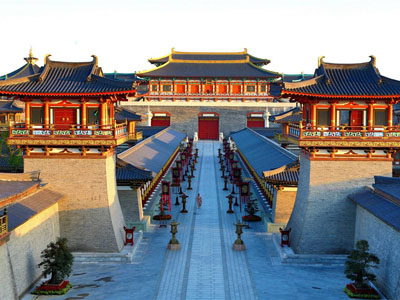
Jiuzhaigou valley is the first nature reserve specially protecting natural scenic spots in China, and also enlisted as the first group of TOP 10 Tour spots in China.
Jiuzhaigou Valley is located in Aba Tibetan Prefecture of Sichuan, and it is a long valley of 50 kms in length composed by three smaller valleys of Shuzheng Valley, Rize Vally and Zhezawa Valley. And the 320 meters wide Luorialang Waterfall in Jiuzhaigou is recorded as the widest in China.
Below are most detailed information about Jiuzhaigou vally,including the attractions of Jiuzhaigou, things to do in Jiuzhaigou, history of Jiuzhaigou and how to book Jiuzhaigou tours.
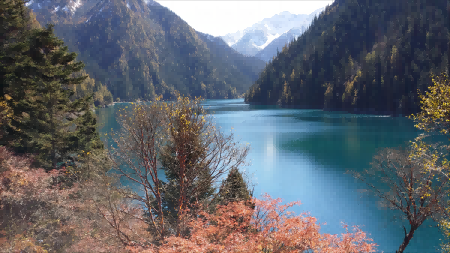
Nuorilang Waterfall
This is an unusual ecosystem, with narrow conic karst landforms, renowned for its rolling mountains, dense forests, colorful lakes, precipitous waterfalls, and a wide variety of birds and animals.
Stretching over 600 sq km in the northern part of Sichuan Province, the jagged peaks around Jiuzhaigou Valley reach heights of more than 4,800 m. In the valley there is a series of diverse forest ecosystems. Its superb landscapes are especially interesting for their narrow conic +arst landforms and spectacular waterfalls. Some 140 bird species inhabit the valley, as well as a number of endangered plant and animal species, including the giant panda and the Sichuan takin.
Physical Features
Lying on the edge of the diverging belt between the Qinghai-Tibet Plate and the Yangtze Plate, there are major faultlines running through the site. Earthquakes are not uncommon and have been a major influence on the geological landscape. Of the greatest interest, geologically, are the high altitude Karst land forms which have been strongly influenced by glacial, hydrological and tectonic activity.
The main valley is 50 km long, and is where Shuzheng, Qunhai, Rize, and Zechawa valleys come together. Waterfalls and streams link 108 lakes of various sizes, many of which are classic ribbon lakes at the base of glacially formed valleys.
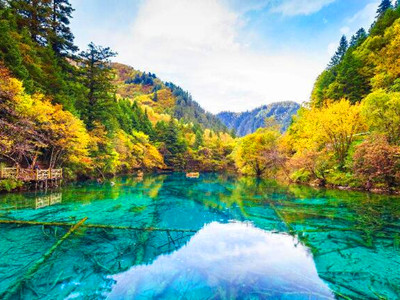

Five Color Lake (Wucaichi)
Also of note are a number of large and spectacular waterfalls, including Xionguashai (Panda Lake) Fall which drops 78m in three steps, and the Zhengzhutan (Pearl Shoal) Fall, which drops 28m in a broad curtain of water, 310m wide.
According to geologists, the lakes were formed by calcium carbonate in the flowing water when the earth was in the interglacial stage. The calcium carbonate could not coagulate, but flowed with the water. More than 12,000 years ago, the global climate became warmer, and the calcium carbonate became active and attached itself to obstacles in the water. As time passed, the attached matter became thicker, forming the milky white banks of barrier lakes.
Five-Flower Lake (Wuhuahai)
The view of Five-Flower Lake in Rize Valley is majestic. Looking down from the mountain, one can see the lake hemmed in on three sides by mountains. The lake looks like a big gourd pouring colorful water endlessly. At the bottom of the lake, there are small, dark-green plum-shaped spots, and in the middle of the gourd is a light-blue figure 10 m long, shaped like the leg of a sika deer. It is said that when the Mountain God appeared on the mountain, a frightened sika seer lost a leg, which dropped into the lake.
The tranquility of the colorful mountain lakes is broken by the many roaring waterfalls downstream. The Nuorilang Waterfall, at the end of the Shuzheng Qunhai Valley, emerges from among willow trees, which seem to comb the 100-meter-wide falls into strands of crystal hair. The most magnificent waterfall in Jiuzhaigou is the Pearl Beach Waterfall in the Rize Valley, roaring down from a sheer cliff, and flying about in all directions. The drops of water reflected in the sunlight glisten like colorful pearls.
At the end of the Zechawa Valley is Changhai (Long Lake), discovered in the 1970s. It is the largest lake in Jiuzhaigou. With an elevation of 3,000 m, the Changhai area is covered in snow all year round. It is especially pleasant to boat on the lake in summer. In spring, the lake mirrors the flowers on the snow-capped mountains. In autumn, it mirrors the red and gold maple leaves. In winter, it is covered with ice.
Flora and Fauna
More than half of the scenic area is covered in virgin forests, with bamboos, flowers, and is home to such rare animals as giant pandas, golden monkeys and white-lipped deer.
Among over 500 categories of seed plant, there are about 92 full species special for their rarity, endemicity, or their ornamental or medicinal use, including 15 species of rhododendron, found between 2,000 and 4,000m, and also two species of bamboo which are important food for giant pandas.
Historic and Cultural Value
The name Jiuzhaigou means the Ravine with Nine Villages, and the area was so named because there were originally nine Tibetan villages there. The local Tibetan population maintain cultural traditions.
The numerous lakes in Jiuzhaigou Valley have evoked religious feelings in the local residents and given rise to many enchanting folktales. According to legend, the goddess Wonosmo dropped a mystical mirror, a gift of love from the god Dag here, and the broken pieces became the 108 lakes. The colorful lakes in Zechawa Valley are said to be the Jasper Lakes of the Queen Mother of the West. According to a local saying, the lake water was colored by the cosmetics of fairy maidens, although it is more likely something to do with the aquatic plants in the lakes. Legends and more recent stories abound concerning the existence of monsters in various lakes, notably Changhai (Long Lake), Jianzhuhai (Arrow-Bamboo Lake) and Nuorilang Lakes. One of these lakes, Wolonghai or Dragon Lake, has a calcareous dyke running through it clearly visible below the water surface, which, in local folklore, has been compared to a dragon lying on the bottom. These stories are a further attraction to tourists and have received some scientific interest.
Legend
Ancient Chinese legend has it that the goddess Semo accidentally smashed her mirror here and the pieces which fell down the mountain formed beautiful lakes, streams and waterfalls. Despite official attempts to attract thousands of tourists, Jiuzhaigou remains a surprisingly peaceful and traditional place. Yaks, shrines and prayer wheels are all common sights.
Weather
Jiuzhai Valley has a subtropical to temperate monsoon climate. In spring, the temperature is quite low and changeable, the average temperature is between 9 to 18 degree. In summer, the temperature is picking up and stable, the average temperature is between 19 to 22 degree, little bit cool at night.In autumn,it’s a pleasant time, but the variable temperature is extreme, especial after October.In winter, this place is extremely quiet. Hotels are closed. and lakes, waterfalls and springs are frozen over. the temperature normally below 0. Day and night temperature is very different inside the scenic spot, warm clothing is essential throughout the whole year.
The total annual rainfall is 761mm but in the cloud forest between 2,700m and 3,500m is at least 1,000mm. 80% of the rain falls occurs between May and October as the monsoon moves up in the valley. Above 3,500m the climate is colder and drier. Snow falls vary but usually falls between October and April.December to February receives the heaviest falls.
The scenery in Jiuzhaigou is impressive all year round but the most popular time to visit is between spring and autumn when the colorful maple leaves are on the trees, and the rainfall is minimal.
Attractions in Jiuzhaigou valley:
Rize valley (ri ze gou/日则沟)
Rize valley runs for 18km from nuorilang waterfall to the virgin forest at the top of the right branch of the “Y”. This valley includes the virgin forest ,grass lake, Swan lake, Arrow bamboo lake/waterfull, Panda lake, Five flowers lake, Peacock riverbed, Pearl shoal, Mirror lake.
The Virgin Forests (yuan shi cen lin/原始森林)
Altitude 3,060m, area 540 hectares
At the Virgin Forest it grows arbors that mainly include firs and spruces, shrubs such as honeysuckles, azaleas, arrow bamboo, as well as thick lichens. This area has a high content of negative oxygen ion which contributes to a natural oxygen bar in the forest!
Grass Lake (fang cao hai/芳草海)
Altitude 2,910m, area 30,000 sq.m.
In summer and autumn, Can you imagine the picture that the grass groves and flowers around the long belt shaped and semi-swamp Grass Lake appear to be yellow, white, red, purple etc, decorated with Waterfowl such as swans, pheasants swoop flying in and out of the flowery banks?
Swan Lake (Tian e hai/天鹅海)
Altitude 2,905m, area 55,000 sq.m, depth 2 - 13m, the widest span 125m
Swan Lake lies in the dense fir woods of Ri Ze Valley, and connected with lower branch of grass lake. It’s a fertile and quiet semi-swamp lake which attracted to swan to nest and breed here. Swans are not only regulars but also migrants to this lake, so check the time if u want to have a date with swan here.
Arrow Bamboo Lake (Jian zu hai/箭竹海)
Altitude 2,618m, depth 6m, area 170,000 sq.m.
The shoreside of Arrow Bamboo Lake is one of the many places where arrow bamboo, the favoured food of the giant panda, used to grow in abundance before it flowered and died.In 2001, Chinese movie director Zhang Yimou who directed the 2008 Olympic opening ceremony selected this site for some scenes of the movie《Hero》because of its beauty.
Arrow Bamboo Falls (Jian zu pu bu/箭竹海瀑布)
Altitude 2,618m, height 7m, width 150m.
It is an arc-shaped waterfall with a large span and small drop. The contrast of the white water and blue lake create a dynamic and extraordinary sight.
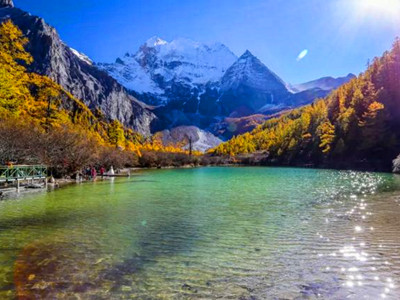
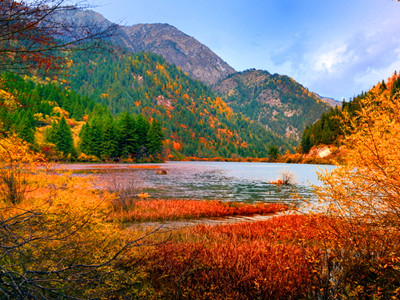
Panda Lake (Xiong mao hai/熊猫海)
Altitude 2,587m, average depth 14m, area 90,000 sq.m.
Next to panda’s favored arrow bamboo lake is panda lake, where panda are said to love to come here to drink and play. Panda is been deeply fond by local people here, but pandas have not been spotted in the area for many years already.
Panda Lake Waterfalls (Xiong mao hai pu bu/熊猫海瀑布)
Altitude 2,592m, height 78m top width 50m, three levels of waterfall
It is the highest and oldest waterfalls in Jiuzhai Valley’s. In summer, the rushing waterfall is quite spectacular. In winter, the waterfalls often freeze completely becoming a ice wall.
Five Flower lake (wu hua hai/五花海)
Altitude 2,472m, depth 5m, area 90,000 sq.m.
The Five Flower Lake is considered as one of the essence of Jiuzhai Valley due to its breathtaking colours which are a result of its lake-bottom travertine and colorful algae. under the action of the sun, calcium carbonated water and different chlorophyll aquatic community are shining in different and incredible colors. Five Flower Lake’s autumn reflections are a spectacular present of nature.
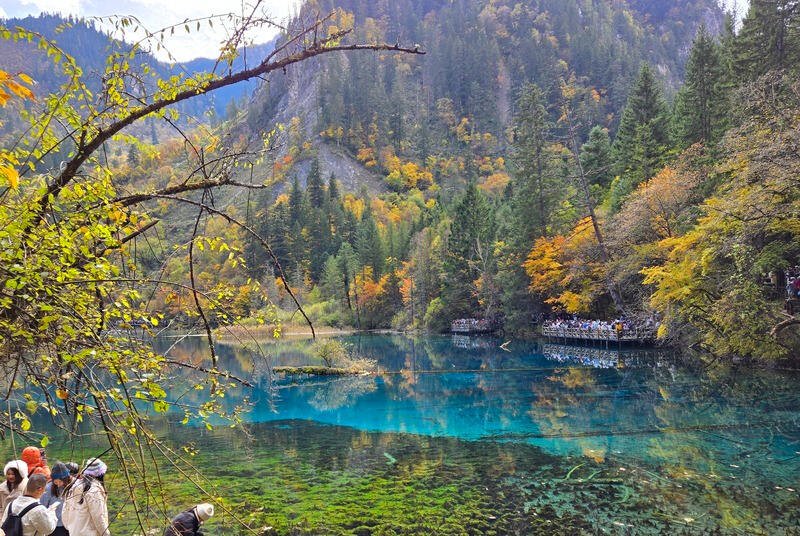
Golden Bell Lake (Jin ling hai/金铃海)
Altitude 2,435m, depth 103m.
The Golden Bell Lakes comprise of one large lake and one small lake twinned together, like a pair of bronze bells. The smaller one being the deepest of all of Jiuzhai Valley’s lakes at 103m. It was formed when gigantic collapsing substances blocked the river. It gets the name as a result of a tree dike that divides it into two lakes that are believed to resemble the shape of two golden bells.
Peacock Riverbed (kong que he dao/孔雀河道)
There is a delicate brook named peacock riverbed,between panda lake and five flowers lake. Hundreds years old trees lying in the river, green grass and trees standing on the sides, birds flying and singing, what a peaceful image!As the named ,the colors in the riverbed looks like the tail of peacock.Lots pf people wondering what created this changeable and amazingly beautiful colors!it is out of imaginatively beautiful in autumn when the colorful trees reflected in the river surface contrasted with the colors and trees lay in the lake.
Pearl Shoals (zhen zhu tan/珍珠滩)
Altitude 2.433m, width 160m, area 95,000 sq.m.
On the irregular travertine surface, Pearl beach is full of small holes, the rushing water hit aganist the holes , under the sunlight, countless water splashing looks like pearl that is how the place got the name. rushing out of the cliff which is 200 meters along on the slope shoal in the deep valley, formed a spectacular pearl shoal waterfall.
Pearl Shoals Waterfall (zhen zhu tan pu bu/珍珠滩瀑布)
Altitude 2,433m, width 310m, highest drop 40m.
Water rushing out from the Pearl Shoals forms a crescent waterfall. This is the most popular point for photograph especial for wedding photos in Jiuzhai Valley.
The waterfall is actually accreting which means it is growing outwards rather than eroding backwards like most waterfalls do. The reason for this is that calcium carbonate is combining with roots, leaves and branches to produce a matrix of cemented plant-stone which then continues to grow once established.
Mirror Lake (Ji hai/镜海)
Altitude 2,390m, average depth 11m, deepest 24.3m, area 190,000 sq.m.
It is named Mirror Lake due to the perfect reflection of the surrounded mountains The spectacular scenery inspired Chinese director, Zhang Yimou to film scenes for the multi-Oscar winning, Crouching Tiger Hidden Dragon here.
Nuo Ri Lang Waterfall (nuo ri lang pu bu/诺日朗瀑布)
This is the widest waterfall and one of the signature pictures of Jiuzhai Valley. 300m wide,and 20m drop.In the late summer when the water level is at its highest, the roaring of Nou Ri Lang waterfall is impressive.In the winter the waterfall usually freezed creating an enormous ice curtain.
Ze Cha Wa Valley (ze cha wa gou/则查洼沟)
Ze Cha Wa Valley stretches 18km from Nuo Ri Lang tourist center at the joint point of the park to Long Lake. This valley include the largest lake --long lake , five colored pool, 2 seasonal lakes
It is just above the bus stop that goes from the Nuo Ri Lang tourist Centre to the Long Lake direction. there are some Tibetan style decorated stores that you can have a quick snack or a cup of yak butter tea. There is a basketball court opposite the village, where many of the locals play basketball. Basketball courts are common in the villages of the area, a sign of the modernizing times perhaps.
About 500m further along the road, the old Ze Cha Wa Village can be seen further down from the road. The local people moved from these wooden homes to more solid homes in the late 1980s and early 1990s.
Long lake (chang hai/长海)
Elevation is 3060m,5km long,600m wide,93㎡.the peaks around long lake has been covered snow throughout the year. This is the highest point visitors can reach in the park. It is really amazing when u stand on the long sea viewpoint, looking at blue sky, white cloud, shining snow all no distance connected,
Long sea is really big and wide,the light is good enough to get a good photo, but some rare good ones were taken in winter. In the tale ,people said there are some big monsters live in this lake, some people even saw that in 1980s,but the strange thing is there is no fish in such a big lake, which added some mysterious romance to this lake, so why not come and find out?
Five Colored Pond (wu cai chi/五彩池)
Altitude 2,995m, depth 6.6m, area 5,645 sq.m.
Walk down from long lake just 1KM is five colored lake,hide deeply in the valley next to the main road. The Five Colored Pond is one of Jiuzhai Valley’s smallest but most gorgeous lakes. The colors are a result of travertine and calcification sedimentation on the lake bed, as well as various algae.
In the legend that the pond was the place where Goddess Semo wash and comb her hair. God Dage came everyday to bring her water from not so far away long lake. The pond’s colors are said to come from Semo's rouge coming off her pretty face and dyed the water.
Upper and lower seasonal Lakes (shang ji jie hai and xia ji jie hai/上季节海和下季节海)
There are two seasonal lakes in Ze Cha Wa Valley quite a distance from each other.The lower seasonal lake is close to Ze Cha Wa Village, in the late autumn,it’s a fertile forage grassland for grazing.The upper-seasonal lake next to the Five-Colored Pond,This is said to be the place where fierce dragons hide themselves and is also called the “Tibetan Dragon Lake”. In the dry season, the Class 1 UN protected, “Ruswich” flower grows on the lakebed.But thinking about the size of the lake and some other beautiful lakes,the upper and lower seasonal lake is more like option for sight seeing in the shuttle bus,too far to walk.
Shu Zheng Valley (shu zheng gou/树正沟)
Shu Zheng Valley is reputed as the epitome of Jiuzhai Valley National Park. Its about 13.8KM from the gate to nuo ri lang tourist center. Its renowned, unpredictable colorful lakes and lake clusters, peaceful and quiet forests, cheerful running streams,which makes u cant help to admire the magic hand of nature.
He Ye Village (he ye zhai/荷叶寨)
The first and largest Tibetan village in Jiuzhai Valley National Park. He ye in Chinese means lotus leaf. As the name implied, the shape of He ye village looks like a stretched lotus leaf. The Tibetan architecture and decoration is worth to have a look.At the back of the village, there is a century old and giant pine tree, with exuberant branches. It is called the "welcoming Pine" to welcome visitors from all over the world.
Bonsai Shoal (Peng jing tan/盆景滩)
Altitude 2,240m.
Its shaped by an unconsolidated porous carbonate sedimentary formation for years in the flowing water. The water runs through various trees that stand in the shoal.its populated by nature,that’s why people call it”the beauty of nature,the nature of beauty” .
Reed Lake (lu wei hai/芦苇海)
Altitude 2,140m, area over 100,000 square metres.
The Reed Lake is a semi-swamp lake with thick reeds, where the blue and green “Jade Ribbon” stream runs down towards to the valley entrance. Because the high elevation,so the reed here is not as strong and tall as the low elevation reeds.and the reed sea is the habitat of waterfowl.
Sparkling Lake (huo hua hai/火花海)
Altitude 2,187m, depth 9m, area 36,000 sq.m.
The sparkling lake populated in the dense forest looks like a mirror when there is no wind. In the sunny day,you can see some sparks jumping and flashing on the surface of the lake, because of the refraction of the sun.
Lying Dragon Lake (wo long hai/卧龙海)
Altitude 2,215m, depth 22m, area 61,000 sq.m.
The exquisite Lying Dragon Lake is typical of Jiuzhai Valley's dark blue. looking through the mirrorlike lake surface , a milky white tufa formation lying in the middle of lakebed like a dragon diving in the bottom.
Shuanglong lake (shuang long hu/双龙湖)
Shuanglong means Double Dragons in Chinese,Through the crystal-clear-like the lake surface , you can see two zonal biological calcium reef dike are lurking on the lakebed,which just like two dragons are hiding and wriggling there,and can flying into the sky at anytime.
Shu Zheng Lakes (shu zheng qun hai /树正群海)
Shu Zheng Lakes has 19 lakes of varied sizes, descending in terraces and surrounded by dense of willows, poplars, pines, spruces and other plants. Water climbs over dikes and runs through grove. Be papered, it’s a feast of your eyes and ears with spectacular colours, verdant woods, dark-blue water, and shallow sing waterfalls. This wonderful scenery is considered by many as the “epitome of Jiuzhai Valley” and it is one of most photographed sites in the park.
Shu Zheng Village (shu zheng zhai/树正寨)
Shu Zheng Village is the biggest and busiest villages in Jiuzhai Valley that about 400 people out of 1000 who live there.Tibetan style log houses stand one after the other and prayer flags wave in the breeze. Many of the locals here operate small stores and sell various Tibetan souvenirs as well as yak butter tea and snacks.
Nine padodas (Jiu zuo ta/九座塔)
Nine padodas placed at the entrance of Shu zheng village which shows the unity of the nine villages in Jiu zhai valley, and pray for luck and happiness. The nine pagodas surrounded by dozens of turning wheels , the biggest one stands for the shu zheng village.
Ancient watermill (Gu shui mo fang/古水磨坊)
Among the shu zheng lakes, there is a trestle bridge cross over the shoal where you can appreciate the rapid water and lakes. After the trestle bridge ,there is a Tibetan style watermill surrounded by prayer wheel which keep runing under the impact of the rushing water. Devout Tibetan compatriots often came here to worship to chant buddhist scripture.
Jiuzhai valley folk culture village (Jiu zhai gou min su wen hua cun/九寨沟民俗文化村)
Jiuzhai valley folk culture village has been built in 1996 ,which located inside of Shuzheng village and aimed at tourists reception service which combined food, accommodation, shopping, entertainment and sight seeing as a whole to serve customers at home and abroad.
Jiuzhai valley folk culture village is an old and typical Tibetan villages with a long history and full-bodied tibetan amorous feelings. It systematically illustrates the jiuzhaigou Tibetan people material culture and spiritual culture. Folk culture village is not only present Tibetan historical and cultural heritage. Folk culture village is not only present Tibetan historical and cultural heritage 、 carry forward the national excellent culture as well as promote friendship of overseas guests and unity of all ethnic groups.
Shu Zheng Waterfall (Shu zheng pu bu/树正瀑布)
Altitude 2,295m, width 62m-72m, height 25m.
It is a round multi-level waterfall consisted by hundreds of water streams running through the stems and trunks of the plant. It is the first waterfall you will see after the entrance,and one of the four biggest waterfalls in jiu zhai national park.
Princess lake (Gong zhu hai/公主海)
Princess lake located among Shu zheng lakes ,it’s a small lake with amazingly peacock blue color.
Tiger Lake (lao hu hai/老虎海)
Altitude 2,298m.
Tiger Lake was named for a number of different reasons. Firstly the Shu Zheng Waterfall at its northern end of the tiger lake roars like a tiger. Also, when the leaves changed colors in the late autumn the reflection of surroundings in the lake looks like tiger’s pattern.And people said its tiger’s favored lake to drink in the valley. So do you want to come here to encounter a tiger?
Rhinoceros Lake (xi niu hai/犀牛海)
Altitude 2,325m, average depth 12m, length 2km, area 200,000 sq.m.
Rhinoceros Lake (Xi Niu Hai) is the second largest in Jiuzhai Valley after Long Lake (Chang Hai). The refection of clouds confuses u to tell which side is the sky which side is the lake. In spring and summer the dense woods and flourish grass present in different colors which provide a stunning reflection in the lake’s surface. It is said that rhinoceros Lake boasts the best reflection among all the lakes in Jiu zhai valley.
Mirror Cliff (Bao jing yan/宝镜岩)
The giant, flat faced limestone Mirror Cliff climbs 400 meters tall. In the legend said that the mirror cliff was built up by Zha Yi Zha Ga, king of all mountains, to suppress a cruel demon.
Zharu Monestary (Zha ru si/扎如寺)
Approximately one kilometer into Zharu Valley, the Zharu Monastery is protected by high mountains--the Mirror Cliff and facing the peak of the Zha Yi Zha Ga sacred mountain.
Built of wood and clay, it is a typical Tibetan monastery, comprising of six parts: the main hall, scripture tower, music platform, tea house and guest hall, with lamas living quarters. The main hall has three golden roofs with four golden bells, and in the front is a gold wheel which symbolizes the life and death transformation. On the wheel is a pair of divine goats. The Statue of Sakyamuni is placed at the centre of the main hall, with religious instruments on the altar, and woollen blankets on the ground where lamas come for their worship their religious belief in the early everyday morning.
Re-construction began on the monastery in 2009 and is being funded by local people and the national park management office. It is scheduled to reopen to the public in 2012.
Zha ru waterfall (zha ru pu bu/扎如瀑布)
Zha ru waterfall hid in the halfway of zha yi zha ga mountain, After the multi-levels falling, finally gets into the embrace of the dell. The flying down torrent looks like a white and holy “hada” ,which is a Tibetan scarf for distinguished guest, to welcome you here with their hospitality.
Dalian lake (Da lian hai/褡裢海)
Da lian means a bag with opening on both ends of the pockets in Chinese.As the name implies,the shape of Da lian lake looks just like that.Da lian lake is not so big but charming with seasonal beauty.
Black lake (hei hai/黑海)
Unpredictable is the main feature of the balck lake. Different time and different angle you can see different lake. Black lake is regarded as a holy lake to pray for rain by local people.
Ganhaizi National Forest Park (Gan hai zi guo jia sen lin gong yuan/甘海子国家森林公园)
Located in between Jiuzhai valley and Huang long scenic area. The region is a mountain lake long time ago, but the lake outlet got wider due to the geological movement, then this place is been called Gan hai zi which means dry sea after the lake shrinked. Gan hai zi is surrounded by dense forest and magnificent mountains which people said not as good as Jiu zhai national park but still a good stop for Jiu zhai and Huang long scenery trip.
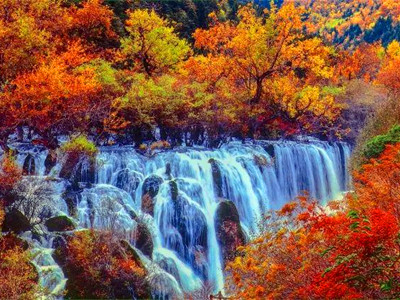
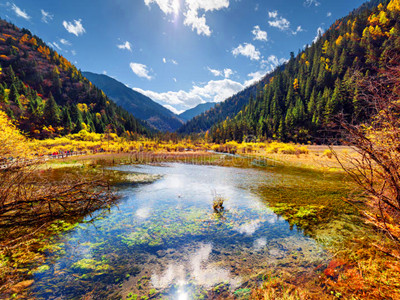
The source of Min river (Min jiang yuan/ 岷江源)
If u ever travel to Chengdu,you must know the most famous river in this area named Min river,which is the the largest water flaw tributary of the Yangtze river. Annual average water flaw is more than 900 cubic meters, more than twice of the Yellow River.But who would think such a big river can started with a small stream located in the northwest Sichuan province the joint of Song pan county and Jiu zhai county. The Min river covers two of the worl heritage of Sichuan province which include Dujiangyan irrigation system –Mount Qingcheng,Leshan giant budda-mount Emei. Now the source of Min river is a very nice spot with beautiful scenery and local snacks ,it’s a nice stop for your Jiu zhai national park trip if you go there by land transportation.
Opening hours
Busy season (1st,Apr -15th,Nov) 7:00am to 7:00pm
Low season (16th,Nov-31st,Mar) 8:00am to 6:00pm
Hotline : 0086-0837-7739753
Tickets Price
runtime type price Total
High season 1st,Apr -15th,Nov admission 220RMB 310RMB
Shuttle bus 90RMB
Low season 16th,Nov-31st,Mar admission 80RMB 160RMB
Shuttle bus 80RMB
Hotel in Jiuzhaigou
1. Intercontinental Jiuzhai Paradise Resort (5*)
The best hotel in Jiuzhaigou valley is the Intercontinental Jiuzhai Paradise Resort .This Jiuzhai hotel is an intimate upcountry retreat nestled high in the mountains, featuring design reminiscent of an ancient city protected under a glass atrium. With over 1,020 rooms, this Jiuzhai hotel is the largest in the region and perfect for leisure travellers seeking comfort and relaxation. Feed your body, mind and soul at this oriental paradise with five restaurants offering Sichuan, Tibetan, Qiang and international cuisine, and our peaceful Tonayu Spa, with its two stunning pools.
Add: Jiuzhai Paradise , Ganhaizi, Zhangzha Town, Jiuzhaigou , Jiuzhaigou, SN 623402 , China, People's Republic of
Tel: 86-837-7789999 (Front Desk)
2. Jiuzhaigou Tianyuan Howard Johnson Resort
Jiuzhaigou Tianyuan Howard Johnson Resort is located in the center of town adjacent to the right side of zhangzha, eternal love, Food street and Commercial Street, traffic is convenient, go to Jiuzhaigou scenic area only need 10 minutes. The hotel was formerly the Jiuzhaigou CTS Le Grand Large Hotel, the big elaborate design after the renovation, the hotel has elegant rooms and suites are designed more than 900 rooms, and 4 unique style restaurant and wine & Cigar bar. In addition to the usual with restaurant and restaurant, hotel Tibetan restaurant lotus flowers is the combination of the local customs and not lose the modern sense of the specialty restaurant.
Add: Jiuzhaigou County zhangzha town
TEl (+86) 0837-7777777
3. Sheraton Jiuzhaigou Resort Hotel (5*)
Sheraton is one of the earliest 5 star hotels in Jiuzhaigou valley, and it is amidst the green mountains and blue waters of a World Heritage Site, offering soothing Tibetan-style décor and grand function spaces.
Add:Jiuzhaigou County zhangzha town
Tel: (837) 773 9988
4. Poly New Jiuzhai Hotel (5*)
The xin jiuzhai valley hotel is in the jiuzhai valley, occupying an area of nearly 40 hectares, among which has a building area of 23,350 square meters. The Xin Jiuzhai Valley Hotel is well in staled with central air conditioning, indoor direct dialing phones and satellite TV systems in the jiuzhai valley district. It started business on June 1,1999 and is co-invested by china trust (hong kong) group company, china poly group company and jiuzhai valley travel company.
Add:Add:Jiuzhaigou County zhangzha town
Tel: (837) 773 4777
5. Qianhe International Hotel (4*)
Add:Add:Jiuzhaigou County zhangzha town
Tel: (837) 773 9188
6. Holiday Inn : Jiuzhai Jarpo
Holiday Inn Jiuzhai Jarpo is open from May-October and closed for the chilly winter months, when flights to the region are limited. The best time to visit us is during high season.
Add: Jarpo Town, Ganhaizi, Zhangzha, , Jiuzhaigou County, , Jiuzhaigou, SN 623402 , China, People's Republic of
Tel: 86-837-7789999 (Front Desk)
China Exploration provide all kind of tour to Jiuzhaigou all the year, and we can also tailor-made the tour for your holiday here. Bellow are part of our tour routes of Jiuzhaigou for your information.
Tour Map of Jiuzhaigou:
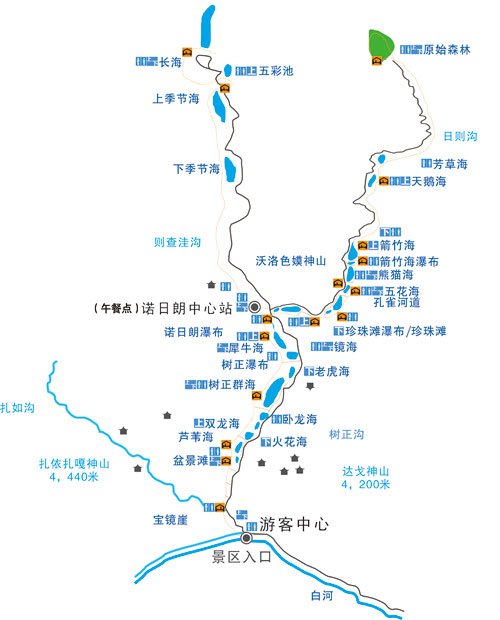
Jiuzhaigou Weather:

More Hotels in Jiuzhaigou Valley:
5 star hotels in Jiuzhaigou Valley:
1. Banyan Tree Jiuzhaigou 2. Jiuzhaigou Tianyuan Howard Johnson Resort Hotel
3. Jiuzhaigou Hilton Resort
4. Jiuzhaigou Paradise Continental Hotel,
5. the Ritz-Carlton Jiuzhaigou Hotel
4 Star Hotels in Jiuzhaiogu :
1. Jiuzhaigou hotel, 2. Jiuzhaigou Guibinlou VIP building, 3. jiuzhaigou Liwan resort hotel, 4. Jiuzhaigou Xingyu International hotel, 5. Poly New jiuzhaigou hotel, 6. jiuzhaigou Qianhe Hotel, 7. Jiuzhaigou Mingya international hotel, 8. Jiuzhaigou Jinlong International resort, 9. Jiuzhiaou Tibetan King Banquet and Dancing hotel, 10. jiuzhaigou Sunshine hotel, 11. jiuzhaigou Jiugong hotel, 12. jiuzhaigou Minshan hotel, 13. jiuzhaigou Resort, 14. jiuzhaigou 12 springs Tibetan Health theme hotel, 15. Jinzhugaou JInzhulinka resort hotel, 16. jiuzhaigou Kang SangLin hotel
How to book Jiuzhaigou tours:
Jiuzhaigou and Huanglong Daily Package Tour
3 Days Jiuzhaigou Private Tours
4 Days Jiuzhaigou and Ruoergai Grassland Tours
8 Days Classic Tours of Jiuzhaigou, Leshan and Chengdu

It is overland tour to Mt. Wudangshan in Hubei province from Xian. Hubei province is located in mid China connecting many provinces in China by convenient transportation of railway, cruise, and flights......
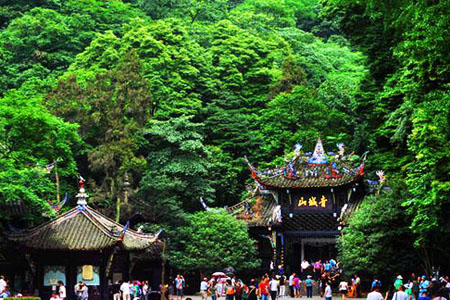
One day classic tours of Chengdu to Mt. Qingchengshan and Dujiangyan Dam will show tourist the profound of ancient Chinese wisdom and culture in harmony relation with the world. ......
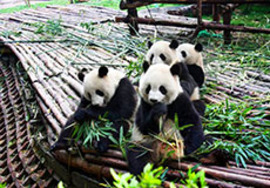
The most classic one day Chengdu tours will bring tourist to Chengdu Giant panda garden and Leshan giant buddha with private travel guide and car in Chengdu, extremely convenient and easy!......

One days best Chengdu tours bring tourist to Sanxingdui museum and giant panda garden with private guide and car, making your tour in Chengdu easy. ......
This panda volunteer work provide tourist with one days unique experience of Panda volunteer project works and bring them an intimate touch with Giant pandas, also the best way to learn deep about pand......
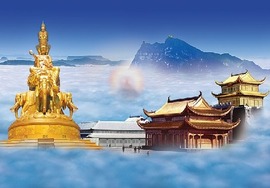
It is tour from the only one operator in Chengdu tours market offering Emeishan and Leshan tours by bullet train. Our highlights including Leshan Giant Buddha and Mt Emeishan. ......

